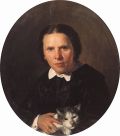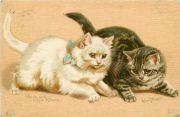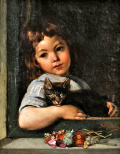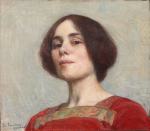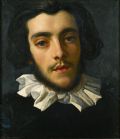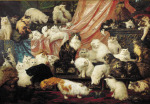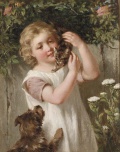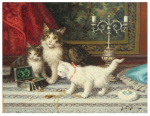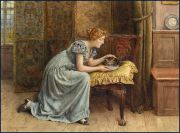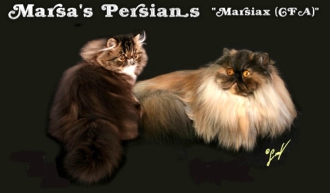
biography of the artists
souce Wikipedia the free encyclopedia
Nikolai Vasilyevich Nevrev (Russian: Никола́й Васи́льевич Не́врев) (1830–1904) was a Russian painter.
Nevrev was born to a family of merchants in Moscow. At the age of 21, Nevrev entered the Moscow School of Painting, Sculpture and Architecture, where he studied under the Russian-Italian painter, Mikhail Scotti. In the 60s, Nevrev painted one of his masterpieces, "The Bargain" (1866), in which he depicted the sale of a serf. His other paintings focused on criticisms of the Church.
He temporarily stopped working in the 1870s, for seemingly unknown reasons, but began painting historical art in the 80s. In 1881, Nevrev became a member of the Association of Travelling Art Exhibitions. Nevrev's best work during this time was arguably his genre paintings, each exhibiting a human moral. At the age of 74, Nevrev lost his son and consequently committed suicide.
Helena J. Maguire was born in London in 1860, the second daughter of Thomas Herbert Maguire (q.v.), and sister of the foregoing. She painted children and animals in water-colour, mostly for children's books, and exhibited at the Institute of Painters in Water-colours, and in the Royal Academy from 1881 to 1892. She died in November, 1909.
Constantin Émile Meunier (* 12. April 1831 in Etterbeek bei Brüssel; † 4. April 1905 in Ixelles) war ein belgischer Bildhauer und Maler. Sein Werk ist dem Naturalismus zuzuordnen.
Constantin Meunier studierte an der Akademie in Brüssel. Er war drei Jahre lang Gehilfe des Bildhauers Charles Auguste Fraikin. 1868 gründete er mit weiteren belgischen Avantgardisten − darunter Charles De Groux und Félicien Rops − die Société Libre des Beaux-Arts in Brüssel. 1880 stellte er im Salon in Gent aus und hatte 1896 großen Erfolg in Paris. 1887–1896 war er Professor an der Academie Louvain. Meunier war Freimaurer[1] und gehörte der Loge Les Amis Philanthropes in Brüssel an.
Meunier begann als Maler und schuf zunächst vornehmlich Bilder mit religiösen Themen. Ab 1880 wandte er sich der Darstellung von arbeitenden Menschen zu. Er kam zu der Überzeugung, dass er diese Thematik besser mit bildhauerischen Mitteln verarbeiten konnte und war nunmehr vornehmlich als Bildhauer tätig. Als solcher wurde Meunier weithin bekannt und anerkannt. Die idealisierte Darstellung von arbeitenden Menschen wurde im 20. Jahrhundert im sozialistischen Realismus weitergeführt. Er gilt als der bedeutendste belgische Bildhauer des 19. Jahrhunderts neben George Minne.
Elin Kleopatra Danielson-Gambogi (3 September 1861 – 31 December 1919) was a Finnish painter. She is best known for her realist works and portraits. Danielson-Gambogi was part of the first generation of Finnish women artists who received professional education in art, so called painter sisters' generation. The group also included artists like Helene Schjerfbeck.
Elin Danielson-Gambogi was born in the small village of Noormarkku, near the city of Pori in Western Finland. At the age of 15 she moved to Helsinki and started studying in the Academy of Fine Arts.
In 1883 Danielson-Gambogi left to Paris. She took lessons at Académie Colarossi and painted in Brittany during the summertime. Few years later Danielson-Gambogi came back to Finland and lived with her relatives in Noormarkku and Pori. In 1888 she opened an atelier in Noormarkku. During the 1880s and 1890s Danielson-Gambogi also worked as teacher in several art schools around Finland.
In 1895 she received a scholarship and traveled to Florence Italy. A year later Danielson-Gambogi moved to the village of Antignano and got married with an Italian painter Raffaello Gambogi (1874–1943). They had exhibitions in Paris, Florence and Milan and in many Finnish cities. The couple also had their paintings in world's fair 1900 in Paris.
Elin Danielson-Gambogi died of pneumonia in Antagnano and was buried in Livorno.
Charles Edward Perugini (1 September 1839 – 22 December 1918), originally Carlo Perugini, was an Italian-born English painter of the Victorian era.
Perugini was born in Naples, but lived with his family in England from the ages of six to 17. He trained in Italy under Giuseppe Bonolis and Giuseppe Mancinelli, and in Paris under Ary Scheffer. He became a protégé of Lord Leighton, who brought him back to England in 1863. Perugini may at first have worked as Leighton's studio assistant. Under Leighton's influence, he began as a painter of classical scenes; then "he turned to the more profitable pastures of portrait painting, and genre pictures of pretty women and children.
In 1874, he married the youngest daughter of novelist Charles Dickens, who as Kate Peruginipursued her own artistic career, sometimes collaborating with her husband. Perugini's 1878 picture A Girl Reading, perhaps his best-known single work, is in the collection of the Manchester Art Gallery. It was bequeathed by James Thomas Blair in 1917.
Perugini's portrait of Sophy Gray, the sister-in-law of Pre-Raphaelite painter Sir John Everett Millais, was for many years mistaken for a work by Millais himself.
Perugini and his wife maintained an active social life in artistic circles of their era. He died in London.
Maxime Dastugue
Émile Vernon, né en 1872, mort en 1919 est un peintre français.
Émile Vernon est élève à l'école des beaux-arts de Tours et y reçoit le premier prix de dessin en 1888. Puis il suit l’enseignement de William Bouguereau et d’Auguste Truphème à l'école des beaux-arts de Paris. En 1898, il participe à l'Exposition des beaux-arts et des arts décoratifs de Tours et débute au Salon des artistes français. Il y expose régulièrement jusqu'en 1913, présentant notamment portraits, paysages et peintures florales.
Il exécute quelques peintures murales comme celles du théâtre de Châtellerault en 1899. Il excelle dans les peintures à l'aquarelle de femmes et d'enfants aux couleurs vives et aux décors bucoliques.
Albert Samuel Anker (* 1. April 1831 in Ins, Kanton Bern, Schweiz; † 16. Juli 1910 ebenda) war ein Schweizer Maler, Grafiker und Genremaler des schweizerischen Volkslebens.
William Stephen Coleman, book illustrator and painter, was born in Horsham in 1829. He studied to be a surgeon and turned to art after practicing for some time. He exhibited between 1865 and 1879 but painted through his whole life. He was a keen naturalist painting for the Illustrated News and the London Almanac. Until 1881 he was on the committee of the Dudley Gallery and he also designed tiles for Minton.
George Percy Jacomb-Hood (1857 - 1929) british painter
Portrait and genre painter, illustrator and etcher. Born at Redhill on 6th July 1857. Studied art at the Slade School, where he won a travelling scholarship and the Poynter Prize, and in Paris under Laurens. Exhibited at the Royal Academy from 1878, and also at the Grosvenor Gallery. Elected R.E. in 1881, N.E.A.C. in 1886, and an original member of the R.P. Illustrated for The Graphic and The Illustrated London News. In 1896 he visited Greece for The Graphic and also went to Delhi for the Durbar 1902. He returned to India for The Graphic between 1905-6 for the tour of the Prince of Wales and again for the 1911 Durbar. Lived in London and died on 11th December 1929.
Carl Kahler was born in Austria and trained in Munich, Paris and Italy, where he won several important prizes. He arrived in Melbourne from London in December 1885, and commenced a successful portrait practice, exhibiting several times with the Australian Artists Association, and numbering the Governor, Sir Henry Brougham Loch, and his family amongst his sitters. However, he is best remembered for three major paintings, The Lawn at Flemington on Melbourne Cup Day (1887); The Derby Day at Flemington (1888-9) and The Betting Ring at Flemington (1889), all owned by the Victoria Racing Club. These works were highly praised in contemporary newspapers, and photographic reproductions of them were soon made by the famous firm of Goupil in Paris. In 1890 Kahler left Australia for New Zealand, whence he travelled to San Francisco. There, he was killed in the earthquake of 18 April 1906.
Der wahrscheinlich größte catcontent aller Zeiten
Mehr als ein possierliches Wimmelbild: In New York versteigerte Sotheby's das gigantischste Katzengemälde der Kunstgeschichte für 826.000 Dollar. Es erzählt weniger von Tieren, als von den Menschen.
Dieses Gemälde muss man als Allegorie auf eine Ehe verstehen. Und wie viele Nebenbuhler sie aushält.
Als der österreichische Künstler Carl Kahler, der sich in Australien und Neuseeland einen Namen als Maler von Pferderennen gemacht hatte, 1891 nach Amerika kam, lud ihn die Millionärin Kate Birdsall Johnson in ihr Anwesen nach San Francisco ein. Dort wimmelte es nur so von Katzen. 350 Perser- und Angorakatzen soll die Dame gehabt haben. Aber nur einen Ehemann.
Symboltier für Toleranz und Treue?
Der muss viel Verständnis für den Spleen seiner Gattin gehabt haben, gepaart mit Humor und Toleranz. Er ertrug nämlich nicht nur den Maler im Haus, der über drei Jahre lang Hunderte von Skizzen spielender, schnurrender, fauchender, sich putzender oder einfach nur dämlich schauender Katzen gezeichnet hatte, um endlich das mit 178 auf 258 Zentimeter größte Katzenbildnis der Kunstgeschichte zu vollenden, sondern gab ihm auch den passenden Titel: "My Wife's Lovers". Mr. Birdsall Johnson hielt seiner Frau bis zu ihrem Tod die Treue.
Einem anonym gebliebenen Katzenliebhaber war das Mammutformat bei einer Auktion von Sotheby's in New York jetzt 826.000 Euro wert, mehr als dem Doppelten des Schätzwerts. Im Jahr 2002 war das Bild bei einer ausschließlich der Gattung Felidae gewidmeten Auktion mit einer Taxe von 500.000 bis 700.000 Dollar noch durchgefallen.
Quelle: msn.com/de/finanzen/top-stories
George Augustus Holmes (1822 - 1911) was a renowned Victorian genre painter. Little has been written about his early life, indeed the exact date of his birth remains unknown. We
do know that he began exhibiting at the Royal Academy in 1852 and at that time he lived with his brother Edward, who was also an artist, at 152 Sloane Square. They both moved to 62 Cheyne Walk in
1870.
George exhibited many paintings at the Royal Academy throughout his life. He also showed at the Royal Society of British Artists, the British Institute and the Royal Society of British Artists of
Birmingham.
Holmes was a talented and popular artist who painted subjects which were very appealing to the Victorian public. He was very skilful in his treatment of figures and animals and in this highly
decorative work we see the artist’s work at its best. The subject is an elegant young lady returning from her morning ride on her favourite pony being welcomed home by her adoring and loyal dog. The
elegance and beauty of the figure reminds us of works by Tissot and the artist’s technical accomplishment is apparent.
Holmes lived and worked in London until his death in 1911.
Emily Farmer (25 July 1826, London - 8 May 1905, Portchester, Hampshire) was an English watercolour painter.
She was one of three children of John Biker Farmer, who worked for the East India Company, and his wife Frances Ann (née Frost). She was home-educated and instructed in art by her brother Alexander Farmer, a genre painter.
She initially painted miniatures, exhibiting two at the Royal Academy in 1847 and 1849, but from 1850 specialised in genre paintings, many of children in rustic surroundings. Kitty's Breakfast (1883), a picture of a girl in a cottage kitchen pouring a saucer of milk for a kitten, is typical of her style. This, along with In doubt (1881), is held at the Victoria and Albert Museum.
Other well-known works include Deceiving Granny (1860), The Primrose Seller (1867), The ABC Class (1863), The Undecided Purchaser (1864), and The Listener (1872).
In 1854 she was elected a member of the New Society of Painters in Water Colours to whose exhibitions she sent ninety-six paintings over a fifty year period. She also showed works at the Liverpool Academy and the Royal Scottish Society of Painters in Watercolour.
Over this period she lived at Portchester House, Portchester, Hampshire, where she died in 1905. She is buried in St Mary's churchyard, Portchester
Jules Le Roy était un peintre de la fin du XIXe et du début du XXe siècle, spécialisé dans les figures d'animaux, essentiellement des chats et chatons, généralement de petit format.
Rudolf Epp (* 30. Juli 1834 in Eberbach; † 8. August 1910 in München) war ein deutscher Maler des Realismus, der der Münchner Schule zugerechnet wird.
Rudolf Epp wurde 1834 in Eberbach am Neckar als Sohn eines Dekorationsmalers geboren. Nachdem er von Jugend an aus eigenem Antrieb zeichnete und sich künstlerisch betätigte, wurde er vom Landschaftsmaler Karl Ludwig Seeger erstmals unterrichtet. Anschließend studierte er an der Großherzoglich-Badischen Kunstschule Karlsruhe als Schüler von Johann Wilhelm Schirmer und Ludwig Des Coudres und besuchte die Kunstakademie Düsseldorf.
Auf Grund seiner offensichtlichen Begabung wurde er durch den damaligen Regenten und späteren Großherzog Friedrich I. von Baden vom Militärdienst beurlaubt. Ein großherzoglicher Auftrag sowie zusätzliche finanzielle Mittel ermöglichten Epp eine Studienreise in den Schwarzwald. Um 1859 fertigte er in der Gegend um Freiburg im Breisgau und Landstuhl zahlreiche Landschaftsstudien.
1862 heiratete er Katharina, geb. Steibl. Nach dem Tod Schirmers siedelte er 1863 nach München über, das als Zentrum der Kunst galt. Hier faszinierte ihn vor allem Carl Theodor von Piloty, der von 1874–1886 Direktor der Akademie werden sollte. In München konnte sich Epp schnell einen guten Ruf als gefragter Maler erwerben.
1868 wurde der später als Offizier geadelte Sohn Franz Ritter von Epp geboren; 1870 folgte die Geburt der Tochter Helene, 1871 kam die zweite Tochter, Augusta Anna zur Welt. Sie blieb bis zum Tode Epps unverheiratet und lebte in der elterlichen Wohnung. Augusta Anna diente ihrem Vater als Modell für verschiedene Porträts und figürliche Darstellungen.
Rudolf Epp war bis ins hohe Alter als Maler tätig, er verstarb 1910 in München. Sein Nachlass befand sich etliche Jahre im Lenbachhaus, der luxuriösen Villa seines 1904 verstorbenen Malerfreundes Franz von Lenbach in München. Ein Teil seines Nachlasses wurde 1914 bei Hugo Helbing in München versteigert.
Anton Laupheimer was a German genre painter who was born in Erbach, near Ulm, on June 23, 1848. He was a student at the Academy of Fine Arts in Stuttgart, eventually
becoming a full professor with a teaching position in Munich. He won medals at Anvers in 1885, Munich in 1890, and Berlin in 1891.
In the second half of the nineteenth century, the private lives of the members of the Roman Catholic Church proved fascinating subject matter for a number of popular painters and patrons. The
popularity of these intimate, behind-the-scenes genre paintings has remained remarkably constant, even more so than other brands of nineteenth century painting.
George Goodwin Kilburne, (24 July 1839 – 1924 London) was an English genre painter specialising in accurately drawn interiors with figures. He favoured the watercolour medium, although he also worked in oils, pencil and - in his early career - engraving.
George was born at Hackford near Reepham in Norfolk, the eldest of the three children of Goodwin Kilburne (1812–1887) and Rebeccca Button (1801–1880).
Kilburne was educated at Hawkhurst, Kent - his father's old school. On leaving at the age of 15, he went to London to serve a 5-year apprenticeship as a wood engraver with the Dalziel brothers, engravers and illustrators. He was highly regarded by his employers who described him as "industrious and constant" and "one of the most satisfactory pupils we ever had".[4] His time as an engraver served him well, allowing him to develop the accuracy and detail which would enhance his subsequent painting. He remained with the firm for a further year before leaving to take up watercolour and oil painting as a profession, quickly becoming one of the most sought after and well-known artists in England.
In June 1862, Kilburne married Janet Dalziel at Old Church, St. Pancras, London. She was the daughter of Robert Dalziel, the painter and brother of the Dalziel brothers. They had three sons and two daughters - of these his eldest son, George Goodwin Kilburne Jnr., became a very well known painter of animals and figures, principally of sporting subjects. In 1881 the family were recorded as living in Hampstead, London.
Janet died in 1882. In 1889 Kilburne married Edith Golightly (34 years his junior) and a further two children ensued - Edith May (Born 1900) and Constance Ivy (born 1902).
Kilburne was a keen sportsman and equestrian and involved himself in hunting, cycling and golf. He possessed a good collection of arms and armour, mainly swords, which often figured in his pictures. He was said to be very quiet and almost retiring in manner, yet very companionable and a friendly and a genial host.
He lived for many years at Hawkhurst House, 39 Steeles Road, Haverstock Hill, Hampstead in London and was a member of the Artists' Society Club at Langham Chambers. At the time of his death, in 1924, he was living at 16, Albion Road, Swiss Cottage, London, but died at his daughter Florence's home, next door to his old house, 38 Steeles Road, Haverstock Hill, Hampstead, London.
